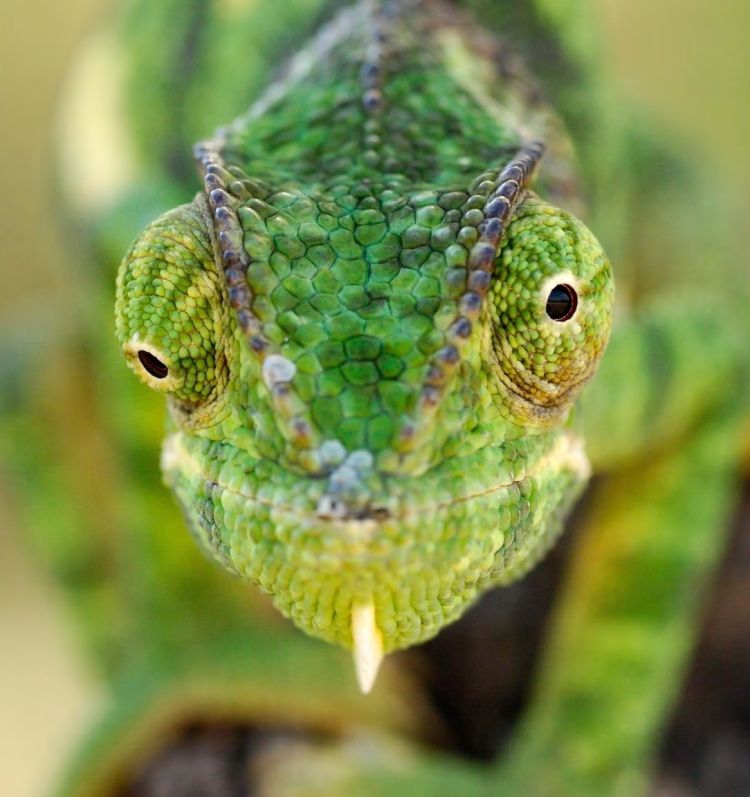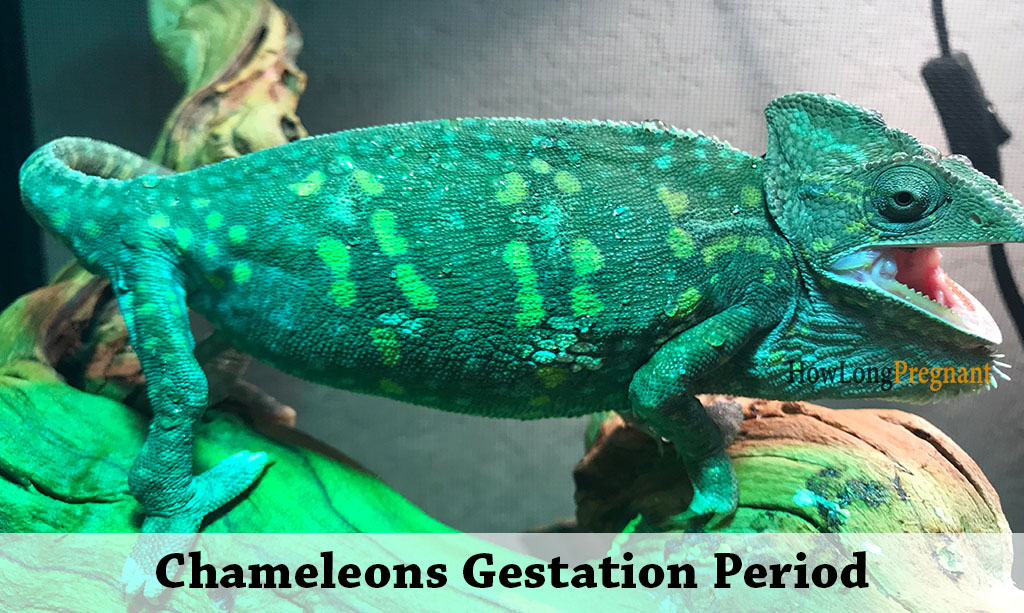Chameleons are famous for their hypnotic color-changing skills and characteristic anatomy, as a result of which they have been a source of great interest to naturalists. Nevertheless, we have always cherished their talent for hiding and eluding our eyes it is evident that the complexities of chameleon reproduction remain mysterious.
The puzzle of the chameleon gestation period will be unmasked in this blog post as we are going to consider some less known facts about their incredible reproductive journey.
In this incredible world, there is an underbelly where unknown information like how courtship rituals work, copulation processes and the time it takes a chameleon to give birth helps these amazing species survive. Let’s look at how chameleons mate and breed to gain insights into who they really are in the context of dinosaurs’ rule millennia ago.
Gestation Period of a Chameleon
When it comes to chameleons, gestation periods extend over an extended timeframe, which can be several weeks or some months. The period depends on a number of issues including how big the species is; hence smaller chameleons usually have shorter gestation periods as compared to the larger ones.
For example, a veiled chameleon has a brief pregnancy that takes about thirty-forty days. However, Jackson’s Chameleon and other large species can take much longer than this even going up for five to six months.
This clearly demonstrates that different species of chameleons have evolved distinct reproductive strategies tailored to their unique habitats and life requirements.

Different Species of Chameleons and Their Gestation Period
In the world, there are over 200 chameleon species. The following are some of the most common chameleons and their gestation period.
- Veiled Chameleon: Approximately 30 to 40 days.
- Jackson’s Chameleon: Often around 5 to 6 months.
- Panther Chameleon: Approximately 4 to 6 months.
- Parson’s Chameleon: Around 6 months.
- Senegal Chameleon: Approximately 5 to 6 months.
- Meller’s Chameleon: Approximately 6 to 8 months.
- Carpet Chameleon: Around 4 to 6 months.
- Oustalet’s Chameleon: Approximately 6 to 8 months.
- Flap-necked Chameleon: Varies, often around 3 to 6 months.
- Four-horned Chameleon: Approximately 4 to 6 months.
- Labord’s Chameleon: Varies, often around 4 to 6 months.
- Fischer’s Chameleon: Approximately 4 to 6 months.
- Montane Side-striped Chameleon: Varies, often around 4 to 6 months.
- Helmeted Chameleon: Approximately 6 to 8 months.
- Rainforest Chameleon: Varies, often around 4 to 6 months.
More About – Chameleon Species
Understanding Chameleon Reproduction
Chameleons exhibit fascinating reproductive strategies that vary across species but generally share common traits. These reptiles are known to reproduce sexually, where males have showy colors and take part in complex courtship moves to attract females.
Once a female selects her mate, copulation takes place through which sperm is transferred into the female’s reproductive tract. Interestingly, some chameleon species can retain sperms for several months after copulation enabling them to fertilize multiple clutches of eggs without further mating.
Upon fertilization, chameleons’ gestation period differs greatly ranging from a few weeks to several months depending on the species, environmental conditions and maternal health. Most female chameleons lay eggs which they bury in moist soil or vegetation for protection against predators and to maintain an optimum condition of incubation.
However, some species like the Jackson’s Chameleon give birth to live young ones which is a rare occurrence among reptiles called viviparity.
Throughout their reproductive cycle chameleons demonstrate astonishing adaptations towards their environments accompanied by remarkable social behaviors thus emphasizing their evolutionary diversity besides ecological roles.
By studying reproduction in Chameleons it enables researchers to understand survival strategies as well as support conservation efforts aimed at preserving these unique reptiles and their habitats.
Egg-Laying Process of a Chameleon
A fascinating and unique reproductive strategy is exhibited by chameleons that revolve around the process of egg-laying. Chameleon females choose carefully a place for nesting after mating, often in the damp soil or plants where they dig holes using their hind legs to lay eggs.
The number of eggs laid can vary significantly among species ranging from a few to several dozens. Once settled inside the nest, at this point, she buries them with soil and leaves so as to camouflage them from predators. Chameleon eggs are characterized by leathery texture and are relatively large compared to the mother’s size.
During incubation, these eggs take in water from their surroundings and hence support embryo development until hatching time informally comes closer and subsequently hatches out completely. This indicates how chameleons have adapted successfully within different habitats, which hinges on environmental conditions for the effective reproduction of such interesting reptiles.

Influence of Environment
Chameleons have a strange dependence on environmental factors during the period of their gestation. The duration that eggs take to hatch is significantly affected by such aspects as temperature and humidity. Typically, these climatic elements bear directly on the embryos inside the shells of the eggs.
Generally, higher temperatures accelerate embryonic growth thus shortening incubation periods while colder ones slow down development leading to prolonged hatching periods. Equally important in this process are levels of humidity which account for egg hydration and embryo development conditions.
In order to enhance successful incubation under favorable conditions, chameleons normally deposit their eggs in moistened areas where they are well protected naturally. In addition to adapting to numerous ecosystems, this sensitivity demonstrates how different environments must be sustained towards reproductive success in captivity as well as in the wild.
This knowledge is essential for those involved in conservation efforts or who keep chameleons as pets. This insight is necessary for people who aim at conserving them and also taking care of them correctly when rearing them domestically because they are extraordinary reptiles.
Also Read - How Long Are Snakes Pregnant For? Learn About Snakes Gestation Period.
Nesting and Egg Deposition
The nesting of chameleons and their eggs laying are very intricate processes that are critical to their reproductive accomplishments. Selection of nest locations is guided by variables such as temperature, and humidity, among others often through digging holes or use of vegetation for suitable conditions.
The eggs are laid one at a time into the well-prepared nests and buried deep in the soil to shield them from predators and fluctuations in weather.
The number of eggs laid varies with individual species; clutch sizes range from a few to several dozen. After deposition, females cover the eggs with substrate or vegetation to camouflage them for better survival prospects.
Several weeks to months duration comprise the incubation period which is primarily influenced by environmental factors. Development is faster at higher temperatures while lower temperatures prolong incubation periods.
During incubation, females may occasionally inspect the nest and make suitable conditions for embryonic growth referments. Chameleon babies when hatched come out complete and ready to begin life on their own terms.
This shows how chameleons adapt in response to their environment and how it affects the successful hatching as well as offspring survival in natural habitats.
Interesting Facts About Chameleon Gestation Period
- Gestation periods among chameleons have a wide range that varies between species. Some chameleons may take a short period of pregnancy while others will take a long time before laying eggs.
- The length of time chameleons are pregnant is closely related to environmental factors. These flexible lizards adjust the duration of their pregnancies depending on temperatures, humidity and the environments they find themselves in.
- Towards the end of their gestation period, female chameleons have elaborate nesting behavior. They choose good locations where they can bury their eggs and provide ideal conditions for incubation so as to ensure the safety of developing young ones.
- Chameleons often bury their eggs in soil or other substrates to protect them. In addition to preventing egg predation, this process also creates a microenvironment suitable for healthy embryo growth.
- The size of the chameleon species impacts its pregnancy term. Smaller types tend to have briefer times till delivery, but larger varieties might have longer durations.
- Chameleons in captivity can change their periods of gestation depending on the living conditions provided by their keepers. For instance, temperature and humidity in captivity may have consequences on the reproductive processes for these reptiles.
- Chameleons have fascinating courtship ceremonies as part of their reproductive mechanism. This is when males show off brilliant colors and perform complicated dances to attract females, signifying the onset of the gestation period.
- This means that chameleons are among animals with hard-shelled eggs rather than live births. The gestation period is the time between fertilization and laying of the eggs.
- These adaptations not only help chameleons survive in hostile environments but also determine breeding strategies for various habitat demands through varying periods of gestation.
- Variability in the length of a chameleon’s pregnancy is a survival tactic. Therefore, by regulating gestational duration to suit environmental conditions, chameleons increase chances for successful reproduction and ensure young ones’ survival across different biomes.

FAQ
What is the length of pregnancy for chameleons?
Oviparous describes animals that lay eggs instead of giving live birth. The period in which a female chameleon carries its young ones after they are fertilized and before it lays eggs varies according to species but usually lasts for some weeks, up to a few months.
What makes a female chameleon take longer to hatch her eggs?
The duration that it takes for the eggs of a chameleon to hatch is largely determined by environmental factors such as temperature as well as biological aspects particular to the species. Bigger lizards take longer time than smaller types.
Can chameleons be able to produce eggs even after not mating with a male before?
No, for the chameleons to lay fertile eggs they need 2 mate. Mating marks the beginning of reproduction and later on development of an egg.
How does a female chameleon choose nesting sites?
Female Chameleons select their nesting sites very carefully burying their eggs in soil or any other medium that will provide protection and a suitable environment for their incubation.
Is it possible for the duration of pregnancy to be affected by conditions in captivity?
Yes, captivity conditions including temperature, humidity and nest substrate can affect the gestation period in these reptiles.
Conclusion
These amazing animals, with their elaborate mating rituals and extraordinary breeding methods, continue to fascinate both scientists and nature enthusiasts. There is more than meets the eye regarding these fascinating animals’ ability to constantly change color.
Intriguingly, it is possible that this chameleon’s graceful navigation of its surroundings has implications for the survival of the species. Every step in their reproductive journey tells a story of the incredible evolutionary wonders of chameleons as a species that have enabled them to thrive in diverse ecosystems.

